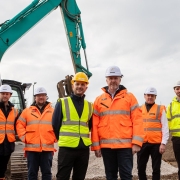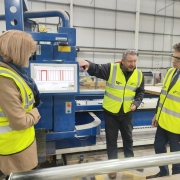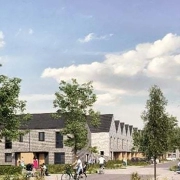Water supply systems for tall buildings must meet demanding standards, with building services engineers needing to balance robust performance with ease of installation. In this article Giles Coombes, Senior Product Manager at Polypipe Building Services, discusses how choosing a system with a tough multi-layer construction can help to solve these challenges.
A robust solution
Water supply systems must be able to perform not only when in use, but also help to facilitate straightforward installation to mitigate the risk of failures that could end up becoming costly. Multi-layer plastic piping systems, such as our own MecFlow Supply System, have been engineered to offer high strength and durability to meet these challenges. Our MecFlow Fusion range uses a pipe material that includes a central layer which has been reinforced by microfibres laid in a mesh formation to provide mechanical strength.
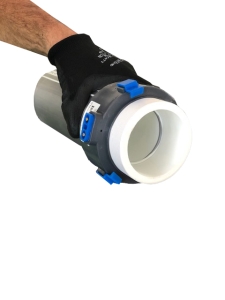 Secure, long-lasting joints are essential to prevent costly failures within a system, which is why we developed our unique patented CLICKWELD technology (left) – to combine all the reliability benefits of an electrofusion weld with added clip connections. This allows for pre-assembly installation before the final weld, cutting installation time on site by up to a third.
Secure, long-lasting joints are essential to prevent costly failures within a system, which is why we developed our unique patented CLICKWELD technology (left) – to combine all the reliability benefits of an electrofusion weld with added clip connections. This allows for pre-assembly installation before the final weld, cutting installation time on site by up to a third.
Where smaller diameter pipework is needed for apartment and corridor installations, press-fit jointing is a reliable option provided it is of sufficient quality. Our MecFlow Press system includes a leak-before-press function with visual inspection windows which give installation teams complete peace of mind that the pipework has been installed successfully.
Durability for the rigours of commercial uses
Within a multi-occupancy tall building, water supplied at high flow rates can create the potential for pipework to transmit noise which must be minimised for the comfort and wellbeing of the occupants. The increased density of a multi-layer composite pipe helps to reduce noise and acoustic vibration, while the smooth internal bore of MecFlow Supply Systems not only reduces noise, but it also includes anti-microbial protection to prevent the build-up of bacteria over time.
It is also highly resistant to abrasive liquids which is essential to noise prevention and long-term use, as wear and tear to pipework over time can change the water flow increasing the potential for pipework noise and system failure. In the case of traditional metal pipework, the possibility of both corrosion and consequent noise is increased, as the metal bore breaks down causing increased resistance and water flow noise which can be transmitted throughout the building.
Pre-fabrication
Tall buildings can throw up unexpected challenges during the build, and so we back our MecFlow Supply systems with dedicated technical and design support for specifiers, contractors, and installation teams. For total control, we provide tailor-made pre-fabrication solutions through our Advantage service.
We can remove many of the risks associated with installing supply systems on-site, as Advantage provides design, fabrication, delivery, and technical support in one end-to-end service. Advantage products are manufactured in a factory-controlled environment where every assembly is air tested as standard to ensure confidence.
REVIT files and environmental product declarations are also available for the MecFlow range. This makes it simple to design a system and create a pre-engineered, data rich 3D model. At the click of a button, you can transfer the design to us to provide a quotation against it.
An ideal choice
The performance capabilities of robust multi-layer pipework systems make them a smart choice when looking for a durable water supply system within a tall building. They are efficient to install, both as a standalone system and when used with a prefabrication service. Yet they’re tough enough to cope with the typical rigours of large construction projects and frequent heavy use. At Polypipe Building Services, we are committed to working with specifiers, contractors, and installers to provide the best solutions for their project – reducing the challenges they face which impact project delivery, and to help them to build better.
For more information about the MecFlow Supply System from Polypipe Building Services visit www.polypipe.com/mecflow


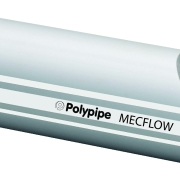
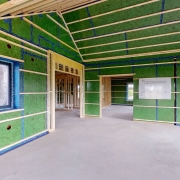
 Testament to the benefits of OSB with built-in vapour and air barrier properties is an exciting regeneration project in Cardiff. Lowfield Timber Frames specified SMARTPLY AIRTIGHT panels alongside a supply of their timber kits for a development of 12, two-bedroom houses in Heath, Cardiff.
Testament to the benefits of OSB with built-in vapour and air barrier properties is an exciting regeneration project in Cardiff. Lowfield Timber Frames specified SMARTPLY AIRTIGHT panels alongside a supply of their timber kits for a development of 12, two-bedroom houses in Heath, Cardiff.
 The industry has recognised that the most effective methods of installing the advanced metering infrastructure is to locate the meter above ground.
The industry has recognised that the most effective methods of installing the advanced metering infrastructure is to locate the meter above ground.
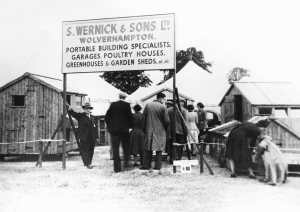 CEO Jonathan Wernick, commented, “Samuel Wernick, my great-grandfather, started his working life as a poultry dealer. He manufactured wooden crates to transport the chickens which led him to start manufacturing as a commercial enterprise. It was Sam’s ability to adapt to the opportunity of manufacturing these crates that led to the birth of the Wernick Group a few years later. This ability to adapt quickly to opportunities remains one of the key strengths of the Wernick Group 90 years later. He would be immensely proud of everything the company has achieved over that time.
CEO Jonathan Wernick, commented, “Samuel Wernick, my great-grandfather, started his working life as a poultry dealer. He manufactured wooden crates to transport the chickens which led him to start manufacturing as a commercial enterprise. It was Sam’s ability to adapt to the opportunity of manufacturing these crates that led to the birth of the Wernick Group a few years later. This ability to adapt quickly to opportunities remains one of the key strengths of the Wernick Group 90 years later. He would be immensely proud of everything the company has achieved over that time.


